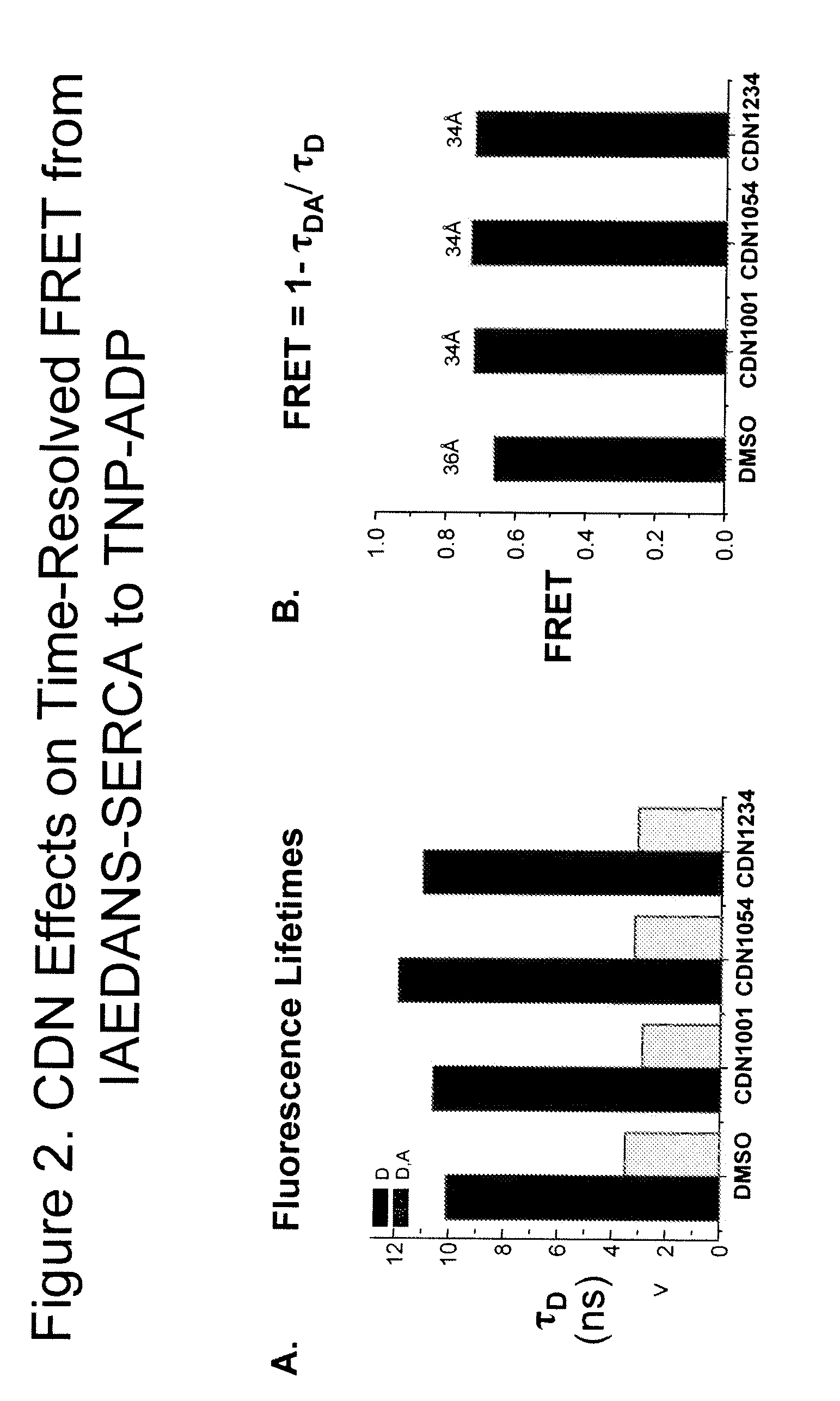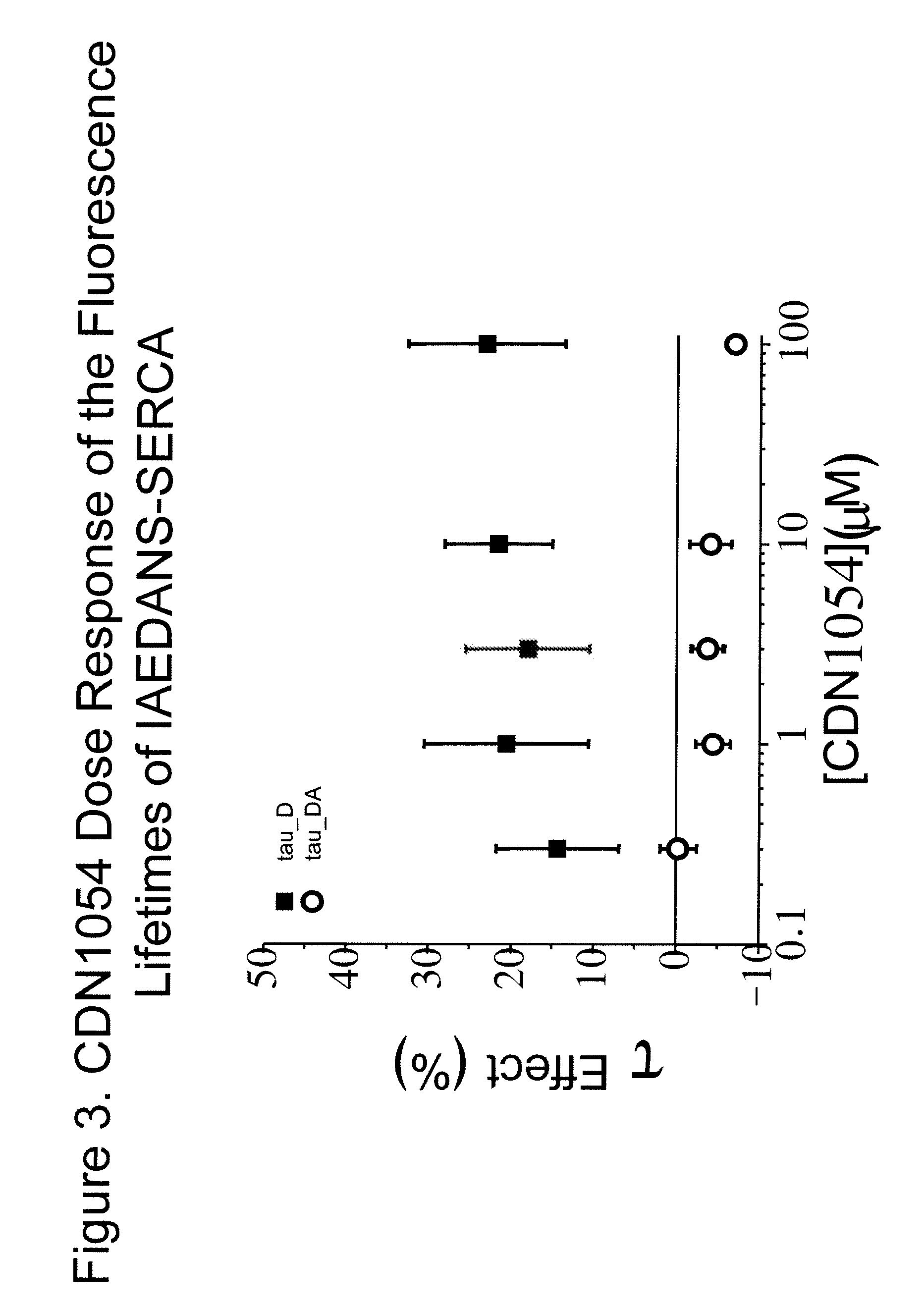Fluorescence resonance energy transfer assays for sarco/endoplasmic reticulum calcium atpase and phospholamban
- Summary
- Abstract
- Description
- Claims
- Application Information
AI Technical Summary
Benefits of technology
Problems solved by technology
Method used
Image
Examples
example 1
Preparation of Crude SR from Rabbit Skeletal Muscle
[0140]Crude SR was purified from skeletal muscle of New Zealand white rabbits. The rabbits were euthanized according to standard procedures recommended by the American Veterinary Medical Association and approved by the Institution's Animal Care and Use Committee on ice in a cold room (4° C.). The fast twitch skeletal muscle was removed from the back and leg and cut into 1 inch cubes. The muscle was then placed in a homogenizer at a ratio of 1 gram tissue / 3 mL SR Buffer (20 mM MOPS, 0.1 M KCl, pH 7.0), blended, and centrifuged at 5,000 rpm in a Sorvall SLA-3000 Superlite rotor for 20 minutes. The supernatant was filtered and collected into a 2 L graduated cylinder. The remaining pellets were homogenized again and centrifuged at 5,000 rpm in a Sorvall SLA-3000 Superlite rotor for 30 minutes. The supernatants were then filtered and the filtrate was added to the previously collected supernatant. The filtered supernatant was centrifuged ...
example 2
Preparation of Porcine Cardiac SR
[0141]The fresh porcine heart was placed into 10 mM (Sodium Bicarbonate Solution 10 mM Tris solution, pH 7.0 with Protease Inhibitors (10 mL / L of solution)) and transported to the lab. Protease Inhibitors contained 10 mL / L Aprotinin (0.1 mg / mL), Leupeptin (0.1 mg / mL), Benzamidine (80 mM), Pefbloc SC (100 mM) and Pepstatin A (0.1 mg / mL). The atria and fat was snipped off from the ventricles. Each ventricle was blended in the Sodium Bicarbonate Solution (about 5 mL / g of tissue) and centrifuged at 11,000×g for 20 minutes at 4° C. The supernatants were filtered through four layers of cheesecloth and stored on ice. The volume of the supernatant volume was measured. KCl was added to the supernatant for a final concentration of 0.6 M. The solution was stirred on ice for 1 hour and centrifuged at 100,000×g for 30 min, 4° C. The resulting pellet was resuspended in 10% sucrose solution with Protease Inhibitors. The solution was centrifuged at 100,000×g for 30 ...
example 3
SERCA Purification and Labeling
[0142]SERCA purification was performed in 0.01% C12E8 by the Reactive-Red method (Mueller et al., (2004) Biochemistry 43:8754-8765; Stokes et al., (1990) Biophys. J. 57:1-14). Briefly, crude SR obtained by procedure as described in Example 1 or 2 was added to reactive red resin type 3000CL with 8 mL 0.01% C12E8. The column was then washed with 300 mL double distilled water and stored in cold room overnight. 0.5 mg of lipid (sonicated DOPC and DOPE, 4:1 ratio by weight / mg protein) was added to the eluted sample, flash frozen and stored in liquid nitrogen. The protein concentration was determined by the Biuret method using BSA as the standard.
[0143]SERCA labeling was carried out essentially as described in Mueller et al., (2004) Biochemistry 43:8754-8765. Prior to labeling, the detergent was removed by the same method used in reconstitution as shown in Example 7. 18.2 μM SERCA was labeled with 273 μM IAEDANS in IAEDANS Labeling Buffer (80 mL KCl, 5 mM Mg...
PUM
 Login to View More
Login to View More Abstract
Description
Claims
Application Information
 Login to View More
Login to View More - R&D
- Intellectual Property
- Life Sciences
- Materials
- Tech Scout
- Unparalleled Data Quality
- Higher Quality Content
- 60% Fewer Hallucinations
Browse by: Latest US Patents, China's latest patents, Technical Efficacy Thesaurus, Application Domain, Technology Topic, Popular Technical Reports.
© 2025 PatSnap. All rights reserved.Legal|Privacy policy|Modern Slavery Act Transparency Statement|Sitemap|About US| Contact US: help@patsnap.com



